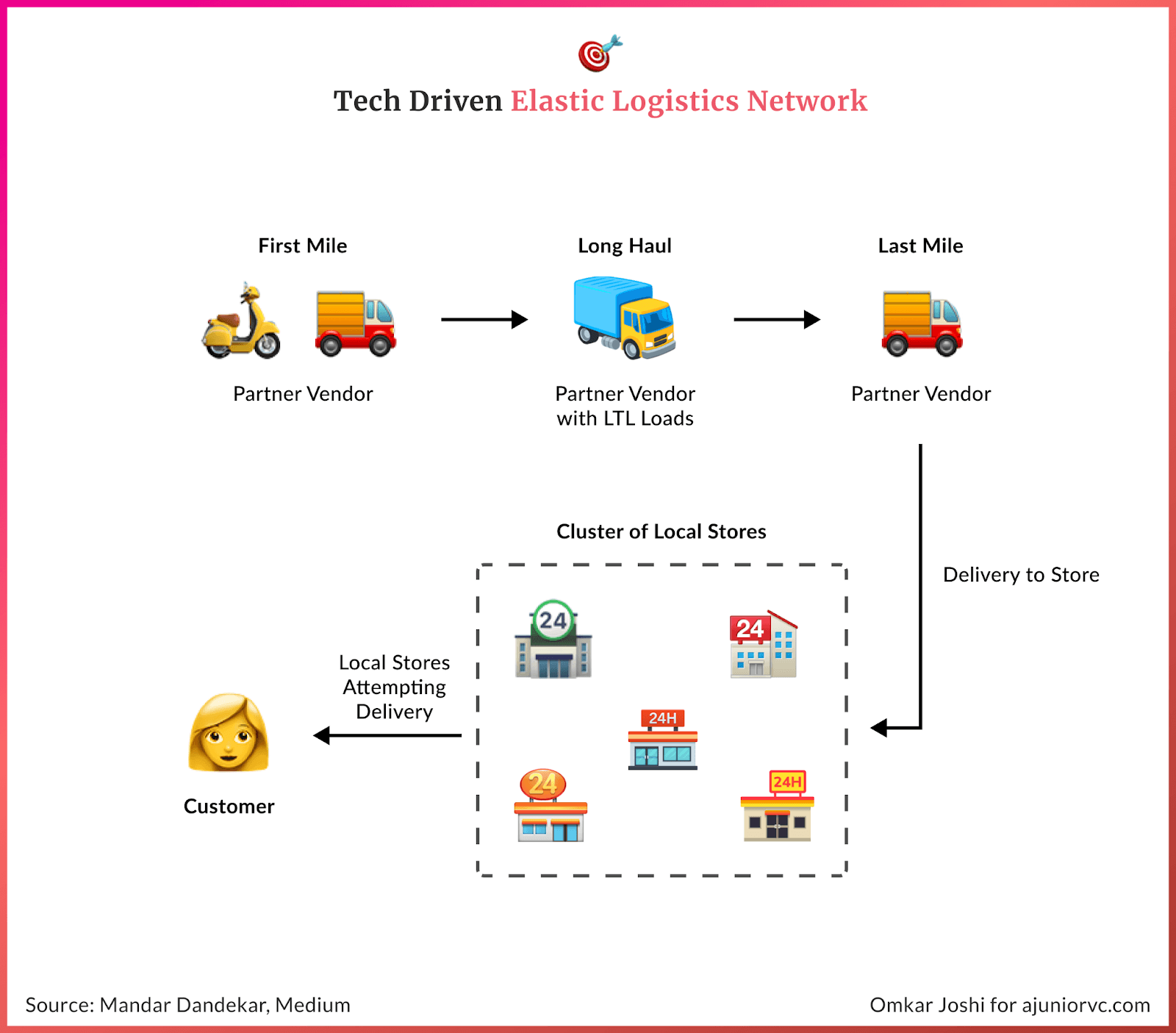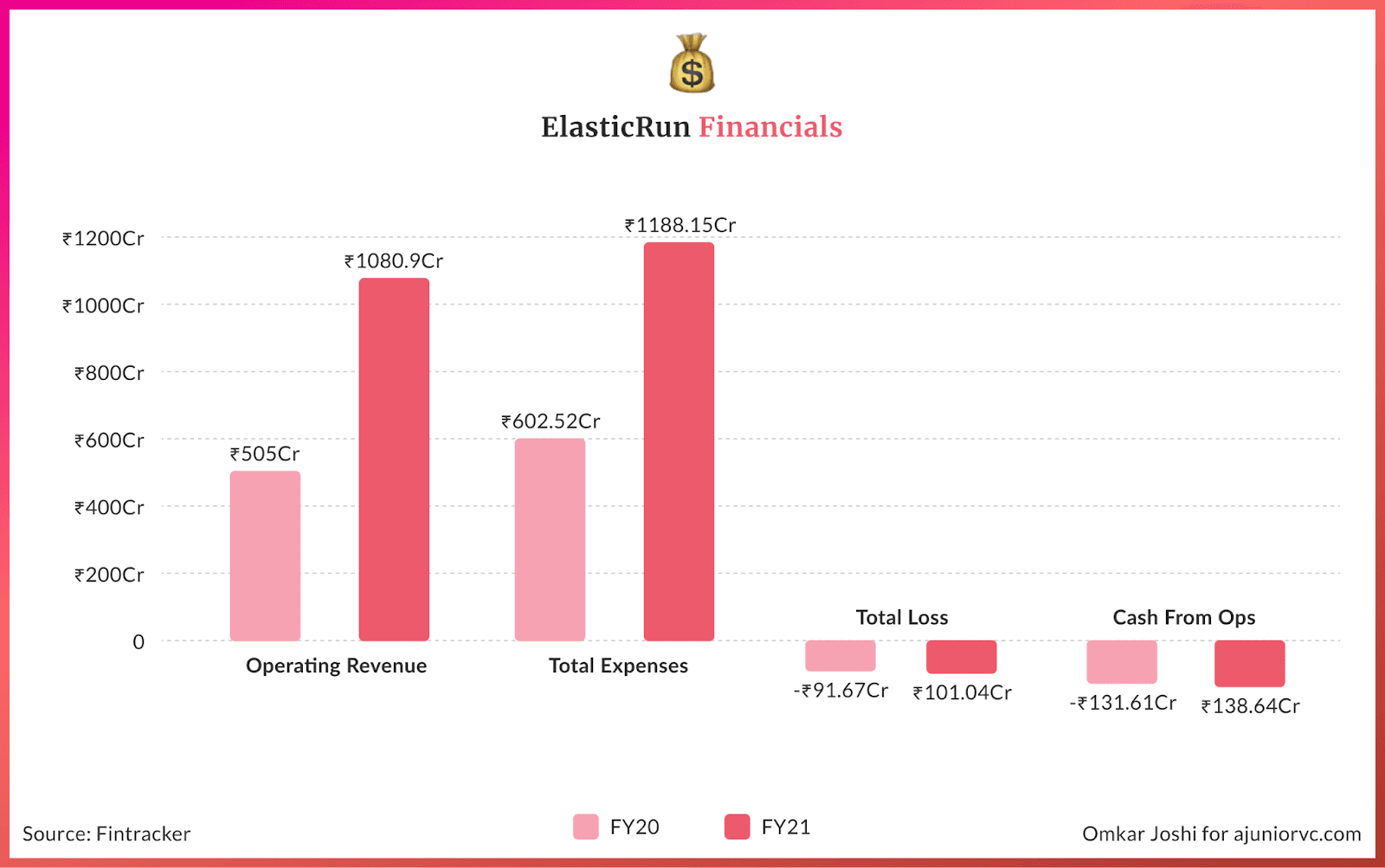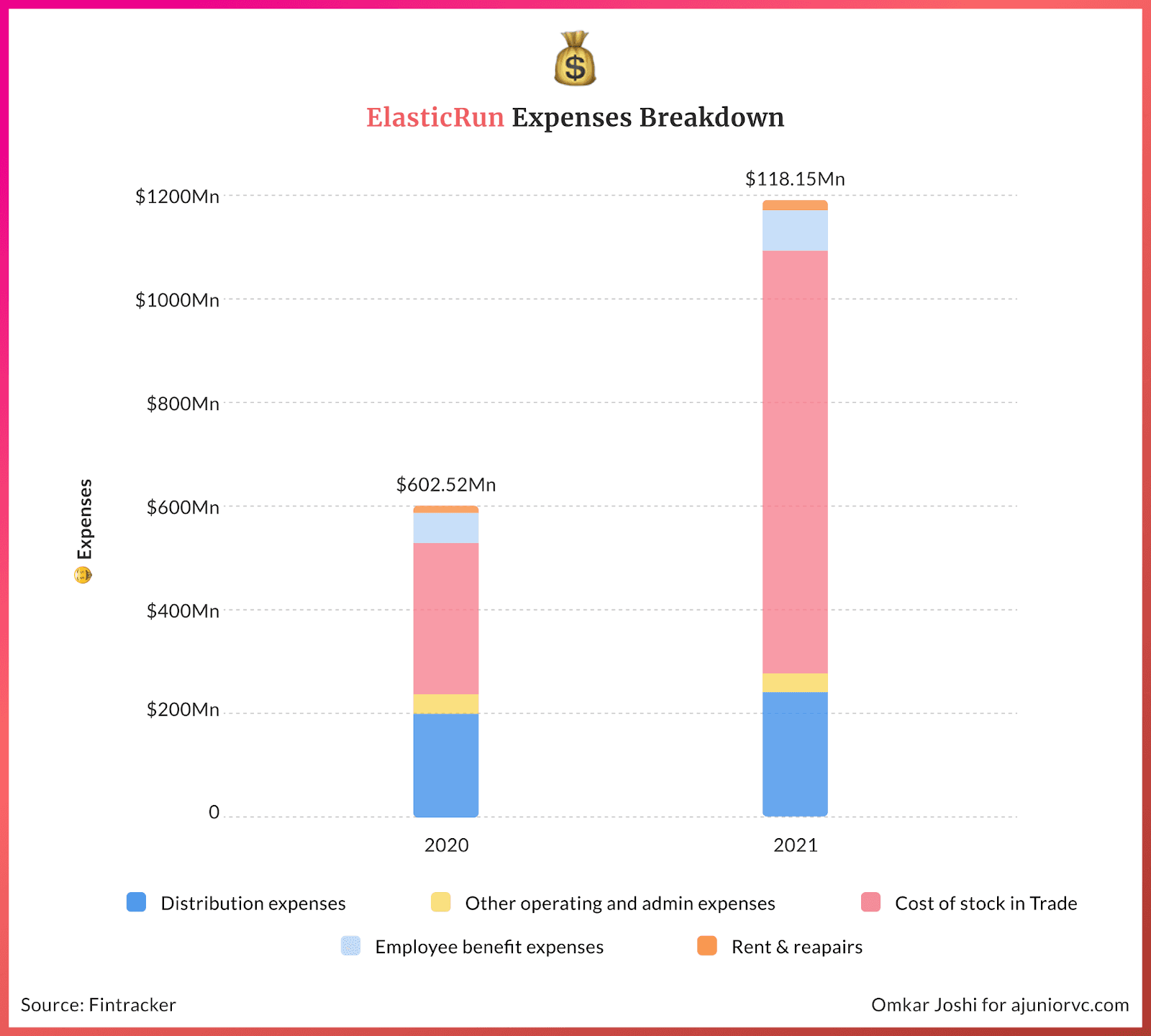
Mar 20, 2022
Can ElasticRun Lay the Tracks for Indian E-Commerce?
Profile
Retail
Logistics
Platform
B2B
Series E-G
Last fortnight, Pune based Elastic Run crossed 1,000 Cr of revenue as it also raised $300M to build yet another Indian unicorn.
Leaving the Door Open
Sandeep Deshmukh grew up in a farming family in Maharashtra’s Pimpalgaon Raja village
The son of a farmer ended up working at Infosys and then Amazon. His professional experience of formulating and executing Amazon’s logistics networks coupled with his personal background provided the right fuel to set up ElasticRun.
From his days at Infosys, Sandeep knew Shitiz Bansal and Saurabh Nigam, who had both just quit their jobs in 2016. The three were ready to take on a new challenge.
The team had been toying with the idea for what would eventually become ElasticRun since 2015, and finally gained conviction to pursue the opportunity full time.
A powerful founding triumvirate, Shitiz was the technological genius, Saurabh brought sheer execution power and Sandeep was the leader of the pack.
But how did the group decide on e-commerce enablement as the problem they wanted to solve?
Growing up in small-town India, Sandeep had seen first hand that consumer goods companies and distributors turned a blind eye to India’s quietest corners as the cost of selling there was higher than their projected returns.
Kirana operators in rural India always struggled to stock fast-moving consumer items, including groceries, due to non-existent distribution networks.
To procure inventory, they had to travel to the nearest large city which was not only expensive but also meant downtime for the Kirana itself and thus lost sales. Last-mile rural connectivity was a missing piece in India’s consumption story.
Sandeep, building the India transportation network for Amazon ground up, was in the heart of the storm. He was likely inspired by Jeff Bezos’ ability to convert solutions that Amazon built for in-house operations into giant P&L items (think AWS) and realized that other retailers would face the same issues that Amazon did when it came to servicing the ‘hidden’ parts of India.
An idea began to form.
Recovering from Bad Habits
Had Paul Graham from Y Combinator met the ElasticRun founders early on in their journey, he would probably say that they are servicing a market suffering from Schlep Blindness.
It was a painful, ubiquitous problem that everyone in an industry goes through but no one thinks to fix. Sandeep and the team spotted the opportunity to build a supply chain infrastructure for India’s far-flung retail stores.
They had the wind in their back.
An increase in mobile penetration and internet access across the country driven by Jio meant the time was ripe to marry the business opportunity with a tech solution.
Having experience working in the transportation technology space and solving problems in global logistics companies, the three founders were well aware of the challenges, understood the market, and had ideas on how the problem could be solved.
In a great example of founding team-market-fit, the early ElasticRun team consisted of folks from companies such as DHL and Amazon. These early team members brought with them deep experience in transportation technology and operations.
When they came out of stealth in 2016 with a buzzy announcement of a $2MM seed round (yes, that was a large seed round back in the day), many thought they were building an Uber for logistics and delivery.
At the time its website described its business as: “ElasticRun is building next-generation transportation technology that will power the e-commerce and distribution industry of India.”
Initial customers included Fortune 500 e-commerce and pharma companies.
At the time the company did two things: last mile and middle mile operations for the e-commerce industry and primary and secondary distribution for pharma companies
Their solution was gaining traction and that was no surprise given the scale of the opportunity.
Momentum was building, for an opportunity that could turn out to be massive.
Fighting for You
The total number of Kirana stores in India are estimated to be close to 13 million.
A majority of these stores are in rural areas. Unlike their urban counterparts, they are small in size – serving only a few people per shop, spread all over the country, and aren’t very well connected to the network of distributors.
This segment is 40% of the country’s retail market, growing annually at 15% compared to cities that are saturating at 3-5%.
In the pre-2016 world, companies had to build their own fixed infrastructure, including warehouses, hire people and then try to service that market.
This was a cost-heavy model, which is why the only companies that were able to do it were large companies that could amortize the cost of the build-out over a large base of customers and years.
With exponentially increasing mobile penetration, any truck driver who had three to four hours of downtime in a remote location or a shopkeeper running a 1,000-sq-ft outlet could become a partner.
In the initial months, ElasticRun gained traction with e-commerce distribution.
Soon, the idea of an asset-light, variable capacity network and rural distribution found acceptance with top FMCG brands.
However, for the founding team to get the ecosystem working took 18 months. The reasons were deeply ingrained in the problem.
Mercy, Mercy My Rural Market
Most FMCG brands followed a standard approach involving a warehouse, a large workforce and high Capex investments.
It was effective in a city with concentrated demand pools, but when brands moved further afield, the economics changed.
To service India, you had to break down that network into 1,000 small pieces and spread them all over the country with every piece or network being self-sufficient.
The partners participating in the network needed to be gig workers and not full-time employees.
By 2018, ElasticRun was able to identify partners in every nook and corner of the country.
A perfect confluence of business model disruption, tech innovation and operational excellence acted as a jetpack that propelled a big idea.
Once the FMCG distribution took shape, building products on top became apparent - for example, offering a credit line to retail stores that were being served by the network.
These new lines of business were built ground-up, from teams who visited the stores and interacted with owners.
As they say, distribution is everything. Elastic Run essentially was converting a Capex heavy distribution model for FMCGs to an Opex light plug and play distribution.
Amazon’s AWS would inspire a lot more than just server led markets.
Right on Time
Post-2018, multiple rounds of capital infusion allowed the company to deepen the network and serve a wider variety of industries.
They made logical extensions to the suite of product offerings. Clearly, investors were drawn to a technology solution in a massive, fragmented, underserved market.
By aggregating resources across channels, the company began to help companies in the pharmaceutical, automotive and food sectors minimize capital on logistics. Many rural stores have never sourced or seen some of the products that they can access today.
Indian e-commerce was expected to grow to a $38.5Bn market by 2026, and similar to the dynamics in China, a lot of this growth will be driven by non-Tier-1 cities.
In addition, the company also used the distribution abilities of the Kirana network to connect banks and financial institutions with underserved SME businesses in rural areas.
On the other side, the company uses data and insights on the rural markets to also help Kirana businesses in optimizing their marketing approach.
After building a massive rural reach and understanding the Kirana business, it is hard not to think of credit. A logical extension was thus to extend lines of credit and provide working capital to shop owners.
Every year, ElasticRun has sought to expand network coverage to new geographies and deepen its reach in existing areas. The network grows stronger with the addition of more retail stores, warehouses and transportation.
Between 2019 to 2021, the company extended its reach from 125,000 to approximately 500,000 retail stores. With the latest funding rounds, the plan is to increase this number to a million.
Happier than Ever
After the initial validation and necessary capital injection, ElasticRun set to expand the network to the 10 million Kirana stores in rural India.
On the front end, it functioned as a simple grocery delivery app, with small stores on one end and FMCG companies on the other. Shop owners can simply place an order for required items, make a payment and wait for it to be delivered.
It is in the movement of products from warehouses to the consumer where ElasticRun differs from traditional distribution networks.
Traditional FMCG and e-commerce companies built fixed capacity networks, where assets do not adjust with varying consumer demand over time. Think warehouses, stockists, wholesalers, retailers, trucks and personnel - these are asset-heavy and inflexible.
At the same time, e-commerce companies tend to have a ‘saw-tooth’ demand pattern, with variations of up to 4x a year. This leaves companies grappling with fixed supply and fluctuating demand, a gap that escalates the cost of service.
Areas with low distribution volumes become unviable for service and during high demand months low network capacity leads to lost revenue. The long tail of Kirana stores are left out of formal distribution and serviced through an unorganized wholesale network.

ElasticRun found that the assets that made up a reliable network - real estate, vehicles and people - already existed on the ground. These needed to be sourced and stitched together using technology to act as a transportation network.
As its name suggests, elasticity in the supply chain was what ElasticRun aspired to bring. Clever in idea, simple to understand but highly complex to execute
A large number of retail stores were used for last-mile delivery, warehouses with extra space for sorting and partially empty trucks for transportation. Some studies estimate the utilization of trucks in India at 40% - leaving sufficient unused capacity.
Such networks are built on the cloud and used only when required, flipping the earlier equation to a variable capacity network.
The backbone of the business was the technology that allowed Elasticrun to stitch fragmented assets together on virtual cloud and provide visibility, control and scalability.
Once the transportation rails are laid, analytics and credit layers are built on top.
The pandemic ridden years saw sourcing becoming a huge challenge in the rural market. Wholesale trade of goods for ElasticRun grew three fold from FY20 to FY21 given their ability to procure and ensure availability at competitive prices.
In mid-2021, the virtual network serves 80k+ villages across 26 states in India and allows e-commerce deliveries at approximately 30% lower cost.
The reason was a crystal clear value proposition for the two sides of its marketplace, the brands and the Kirana network.
I Get my Peaches out in Jodhpur
The solution had a clear value proposition for companies across FMCG, pharma and e-commerce. ElasticRun helped them penetrate the rural areas and learn more about otherwise untouched customers.
While the Kirana commerce space saw players like Flipkart, Udaan and Reliance’s JioMart build a large presence, the ElasticRun solution was tailored for the rural market.
Unlike urban retail which was reliant on deals and discounts, the rural side depended on fulfillment cost and availability.
The underlying ecosystem is built around small ticket sizes and long distances.
A typical brand would gain access to half a million incremental stores. By early 2021, ElasticRun thus becomes an extended arm of the direct distribution network for top consumer brands such as Coca Cola, Britannia, Dabur and ITC.
This increase in exposure served as an important toolkit in ElasticRun’s business model, again analogous to Amazon’s famous flywheel.

More traffic for customers on ElasticRun’s platform led to more sales for customers which led to economies of scale and cheaper costs for ElasticRun.
A more cost-efficient structure allowed ElasticRun to price their services more competitively and win more business, which leads to more traffic.
Magic
Two major revenue sources for the company are the wholesale trade of goods with small store owners and freight services to big brand companies.
Moreover, once these networks penetrated the far-flung rural areas, they were able to provide 300+ brands with valuable insights on rural commerce.
Network growth has not come at a major compromise on profitability. Structurally, the distribution and logistics costs are variable and do not present a Capex burden on the business.
In fact, profitability might not be too far away. The company exploded to 1,000 Cr of revenue at the end of FY21.

With improving inventory turnover - 34.17 times in FY21 vs 18.46 times in FY20 - the company was able to deliver 3X higher volumes, pointing to an efficient operation that can further benefit from technology improvements.
Get Yo Drivers License
2021 ended up being a huge year for ElasticRun.
Revenue from operations jumped 2.14 times to Rs 1,081 crore in the 2021 financial year, as opposed to Rs 505 crore in 2020. It currently aggregates supply from over 400 FMCG brands, and offers its logistics services to rural stores in over eighty thousand villages across 26 states in India.
In fact, it became a unicorn at the start of last month after scoring a mammoth $300 million funding round and planned to use the capital to expand further into more villages.
Interestingly, ElasticRun is one of the rare unicorns showing fiscal discipline in the age of profligacy and BMW bikes. It seems it is close to turning profitable soon, as it almost hit break-even point, spending Rs 1.1 to earn a single rupee of operating revenue.
What is also interesting is how the share of revenue between wholesale trade and services has changed, going from just over half in 2020 to nearly 80% in 2021.

Further, an examination of its finances also showed that the majority of its expenses are in the procurement of FMCG goods, which accounted for 68.6% of its revenues.
This proportion is likely to rise in line with the wholesale and retail food inflation and global commodity price spike caused by the ongoing crisis in Ukraine and war with Russia.
On the other hand, distribution and logistics - the process of actually getting the goods to the last mile - accounted for 20%.
The government’s push for increased infrastructure spending in this budget might mean that as infrastructure improves, the cost of moving goods around will decrease.
As ElasticRun continues to scale, their future will depend more on being able to efficiently operate their complex logistics network than anything else.
Everything I Wanted, But Not Competition
Tackling any large market with a solution that works means you won’t be alone for too long.
The two big competitive threats to ElasticRun come from the landscape (“what if other players target our Kirana stores”) and the mode of delivery (“what if people stop buying from Kirana stores”).
ElasticRun was able to carve out a niche for itself where it was undisturbed for a while - serving rural Kirana stores.
But there’s an 800-pound gorilla lurking, Udaan.
Udaan is India’s biggest B2B e-commerce platform and onboarded over 5 lakh new retailers alone in 2021. It shipped over 260 million products across 1000 towns and cities.
Till now, ElasticRun is counting on Udaan essentially ignoring the space they are playing in, but the beefy tech infrastructure and formidable sales presence that Udaan has meant that it is only a matter of time before it also starts dipping its toes into these waters.
Another dark horse is our old friend DeHaat, which is very similar to ElasticRun in a lot of ways - but with a greater focus on agricultural inputs. They might decide to expand into the consumer good side of things as well.
But the bigger, and less quantifiable competitive challenge comes from changing consumer habits.
Players like DealShare, JioMart and Meesho are trying to get rural customers used to get groceries delivered to their houses, bypassing the kirana store altogether. How well does a Kirana-oriented business model hold up when people stop buying from Kiranas themselves?
Another interesting shift will be the increasing urbanisation of India itself as people leave villages for booming towns and cities.
Many of the urban areas identified in Census 2011 have expanded while thousands of villages have turned into towns, as per the census definition, officials say. This would mean smaller populations in rural areas and a smaller TAM for a company like ElasticRun.
Zooming out, ElasticRun today sits at the crossroads between a massive opportunity and some existential threats from the competition and consumer trends.
If the company’s historical performance is any indicator, ElasticRun will succeed in laying the tracks for Indian e-commerce in the years to come.
Writing: Varun Varma, Shiraz Kazmi, Chandra SV, Rajiv Nagpal and Aviral Bhatnagar Design: Omkar Joshi